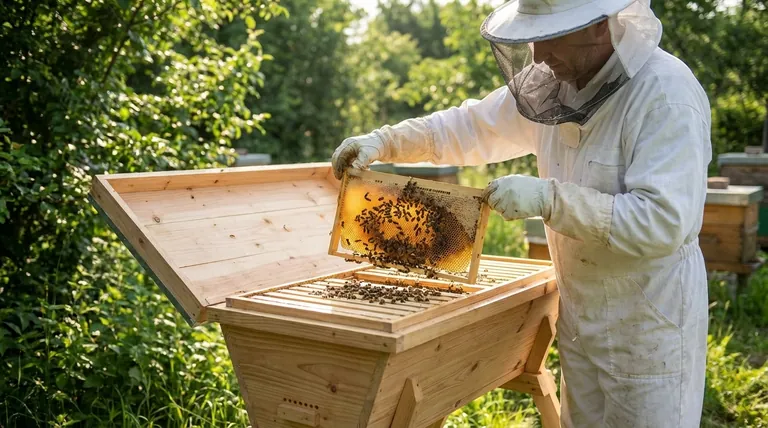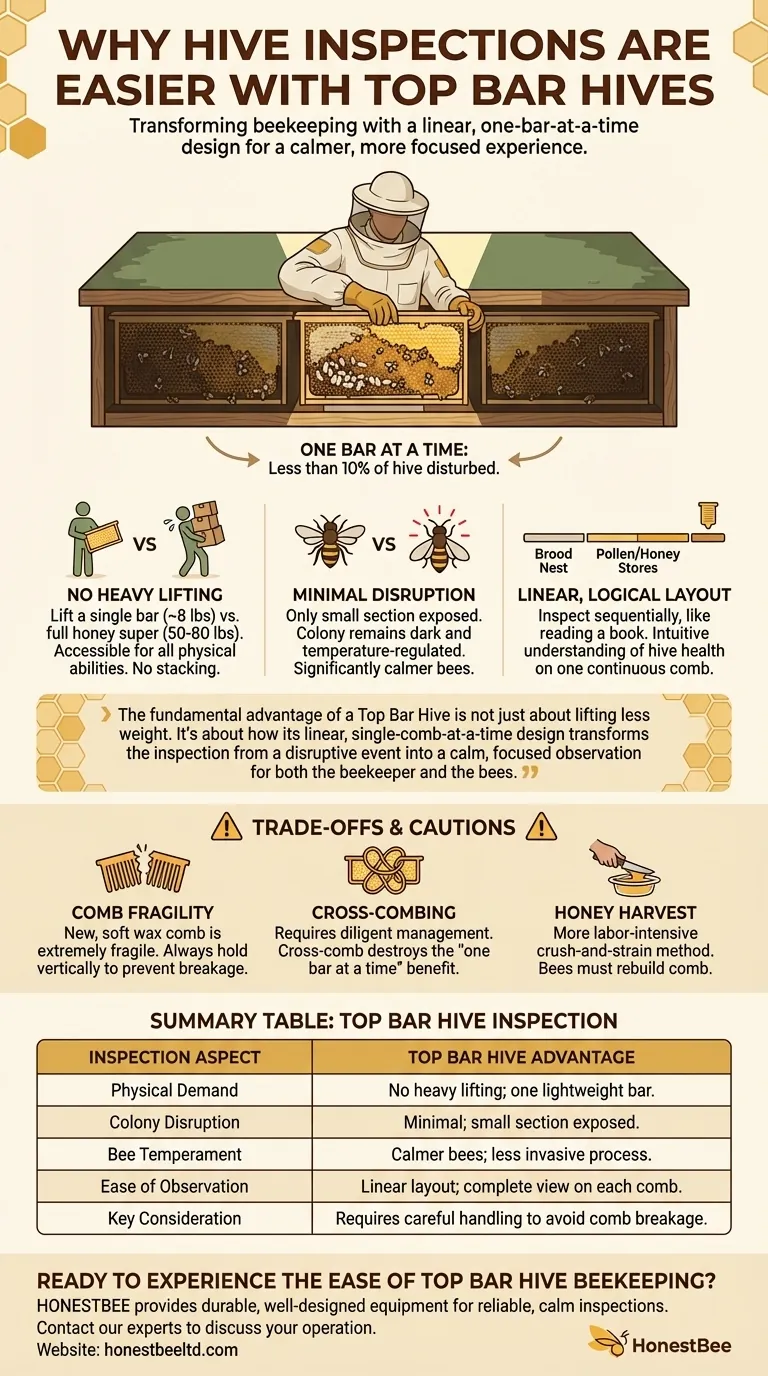At its core, a Top Bar Hive inspection is easier because the design allows you to interact with the colony one small section at a time. Unlike other hive types that require lifting heavy boxes and exposing the entire colony at once, you only remove and inspect a single comb, which is lighter, less disruptive to the bees, and less physically demanding for the beekeeper.
The fundamental advantage of a Top Bar Hive is not just about lifting less weight. It's about how its linear, single-comb-at-a-time design transforms the inspection from a disruptive event into a calm, focused observation for both the beekeeper and the bees.

The Core Principle: One Bar at a Time
The horizontal, single-story design of a Top Bar Hive (TBH) is the source of its simplicity. You don't stack boxes; instead, you manage a series of individual bars laid across the top of a long trough. This changes everything about the inspection process.
Minimal Colony Disruption
When you open a Langstroth hive, you remove the lid and inner cover, exposing the entire top of a box—an area of over 250 square inches—to light, air, and temperature changes. This is an immediate, large-scale alarm for the colony.
In a TBH, you slide over the cover just enough to access one single bar. The rest of the colony remains dark, protected, and temperature-regulated. You are disturbing less than 10% of the hive at any given moment.
A Calmer, More Focused Inspection
This minimal disruption results in significantly calmer bees. Because the entire colony isn't put on high alert, you face a far less dramatic defensive response.
This allows you, the beekeeper, to work more slowly and deliberately. The experience becomes less about "getting in and getting out" and more about careful observation, making it ideal for learning bee behavior.
No Heavy Lifting
This is the most celebrated benefit. A full honey super on a traditional hive can weigh 50 to 80 pounds. An entire inspection requires lifting and restacking these heavy, awkward boxes.
In a TBH, you only lift one bar at a time. A single bar, heavy with honey, rarely exceeds 8 pounds. The entire inspection process involves no significant lifting, making it accessible to people of all physical abilities.
How the Design Simplifies the Work
The benefits extend beyond just lifting. The entire workflow of an inspection is streamlined.
A Linear, Logical Layout
Inspecting a TBH is like reading a book from left to right. The colony naturally organizes itself with the brood nest in the center, and honey and pollen stores on either side.
To find the queen or check the brood pattern, you simply start at one end and work your way through the bars sequentially. There's no guesswork about which box contains the brood nest.
A Complete Picture on One Comb
Each bar you lift gives you a complete snapshot of that slice of the hive. You can see the brood pattern, pollen stores, and nectar or capped honey all on one continuous piece of comb.
This provides an immediate and intuitive understanding of the colony's health and resources in that specific location.
Understanding the Trade-offs and Cautions
The simplicity of the TBH comes with unique challenges that are critical to understand. This design is not inherently "better," but different.
The Fragility of New Comb
The greatest risk in a TBH inspection is comb breakage. Bees build their own comb down from the bar without the four-sided support of a traditional frame.
New, soft wax comb is extremely fragile. You must always hold the comb in a vertical position, like a plate on its edge. Tilting it horizontally, especially on a warm day, will cause it to detach from the bar and break, destroying brood and honey.
Cross-Combing Can Halt Inspections
If bees build comb that attaches across multiple top bars (cross-comb), it destroys the entire "one bar at a time" benefit. Trying to pull a cross-combed bar will tear apart the hive structure.
This requires diligent management, especially when the colony is new, to ensure they build straight comb along the provided guides on each bar.
Honey Harvest Is Different
While inspections are easier, honey harvesting is more labor-intensive. You can't use a centrifugal extractor because the comb is frameless. The standard method is crush-and-strain, where you cut the comb off the bar and process it. This also means the bees must rebuild that comb from scratch.
Making the Right Choice for Your Goal
The ease of a Top Bar Hive inspection is a defining feature, but it must align with your personal beekeeping philosophy and physical needs.
- If your primary focus is minimizing physical strain: The no-heavy-lifting nature of a TBH makes it the undisputed choice.
- If your primary focus is a natural, less-intrusive approach: The minimal disruption of a TBH inspection is perfectly aligned with this goal.
- If your primary focus is maximizing honey production and efficiency: The standardized equipment and faster extraction methods of a Langstroth hive may be a better fit.
Ultimately, choosing a Top Bar Hive is a choice for a more deliberate, physically accessible, and deeply connected beekeeping experience.
Summary Table:
| Inspection Aspect | Top Bar Hive Advantage |
|---|---|
| Physical Demand | No heavy lifting; inspect one lightweight bar at a time. |
| Colony Disruption | Minimal; only a small section of the hive is exposed. |
| Bee Temperament | Calmer bees due to less invasive process. |
| Ease of Observation | Linear layout provides a logical, complete view on each comb. |
| Key Consideration | Requires careful handling to avoid fragile comb breakage. |
Ready to experience the ease of Top Bar Hive beekeeping?
As a trusted supplier for commercial apiaries and beekeeping equipment distributors, HONESTBEE provides the durable, well-designed equipment you need to succeed. Our wholesale-focused operations ensure you get reliable gear for a calmer, more manageable inspection routine.
Contact our experts today to discuss how our Top Bar Hives and other supplies can benefit your operation.
Visual Guide

Related Products
- Top Bar Beehive for Beekeeping Wholesales Kenya Top Bar Hive
- Long Langstroth Style Horizontal Top Bar Hive for Wholesale
- HONESTBEE Professional Long Handled Hive Tool with Precision Cutting Blade
- HONESTBEE Professional Multi-Functional Hive Tool with Ergonomic Wood Handle
- HONESTBEE Advanced Ergonomic Stainless Steel Hive Tool for Beekeeping
People Also Ask
- How is honey harvested from a top-bar hive? A Guide to Simple, Low-Equipment Processing
- What are the key features of the Kenyan Top Bar Hive? A Guide to Simpler, Natural Beekeeping
- What are the benefits of extra wax production in top bar hives? A Natural Byproduct for Craft & Efficiency
- What are the labor requirements for a KTBH vs. Langstroth hive? A Guide for Apiary Efficiency
- What is the quickest method to harvest honey from a top bar hive? A Guide to the Simple 'Cut and Crush' Method



















